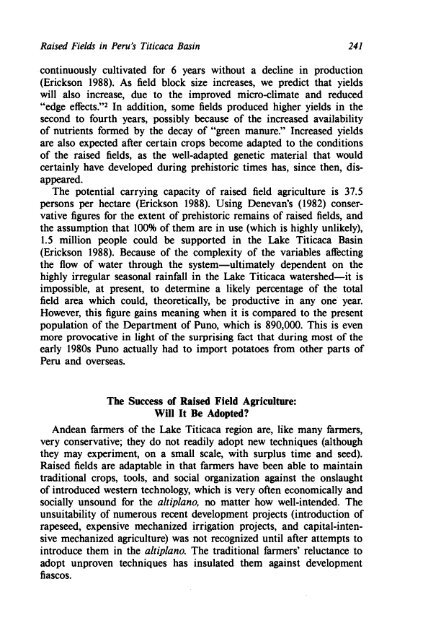Fragile Lands of Latin America Strategies for ... - PART - USAID
Fragile Lands of Latin America Strategies for ... - PART - USAID
Fragile Lands of Latin America Strategies for ... - PART - USAID
Create successful ePaper yourself
Turn your PDF publications into a flip-book with our unique Google optimized e-Paper software.
Raised Fields in Peru's Titicaca Basin 241<br />
continuously cultivated <strong>for</strong> 6 years without a decline in production<br />
(Erickson 1988). As field block size increases, we predict that yields<br />
will also increase, due to the improved micro-climate and reduced<br />
"edge effects."2 In addition, some fields produced higher yields in the<br />
second to fourth years, possibly because <strong>of</strong> the increased availability<br />
<strong>of</strong> nutrients <strong>for</strong>med by the decay <strong>of</strong> "green manure." Increased yields<br />
are also expected after certain crops become adapted to the conditions<br />
<strong>of</strong> the raised fields, as the well-adapted genetic material that would<br />
certainly have developed during prehistoric times has, since then, dis-<br />
appeared.<br />
The potential carrying capacity <strong>of</strong> raised field agriculture is 37.5<br />
persons per hectare (Erickson 1988). Using Denevan's (1 982) conser-<br />
vative figures <strong>for</strong> the extent <strong>of</strong> prehistoric remains <strong>of</strong> raised fields, and<br />
the assumption that 100% <strong>of</strong> them are in use (which is highly unlikely),<br />
1.5 million people could be supported in the Lake Titicaca Basin<br />
(Erickson 1988). Because <strong>of</strong> the complexity <strong>of</strong> the variables affecting<br />
the flow <strong>of</strong> water through the system-ultimately dependent on the<br />
highly irregular seasonal rainfall in the Lake Titicaca watershed-it is<br />
impossible, at present, to determine a likely percentage <strong>of</strong> the total<br />
field area which could, theoretically, be productive in any one year.<br />
However, this figure gains meaning when it is compared to the present<br />
population <strong>of</strong> .the Department <strong>of</strong> Puno, which is 890,000. This is even<br />
more provocative in light <strong>of</strong> the surprising fact that during most <strong>of</strong> the<br />
early 1980s Puno actually had to import potatoes from other parts <strong>of</strong><br />
Peru and overseas.<br />
The Success <strong>of</strong> Raised Field Agriculture:<br />
Will It Be Adopted?<br />
Andean farmers <strong>of</strong> the Lake Titicaca region are, like many farmers,<br />
very conservative; they do not readily adopt new techniques (although<br />
they may experiment, on a small scale, with surplus time and seed).<br />
Raised fields are adaptable in that farmers have been able to maintain<br />
traditional crops, tools, and social organization against the onslaught<br />
<strong>of</strong> introduced western technology, which is very <strong>of</strong>ten economically and<br />
socially unsound <strong>for</strong> the altiplano, no matter how well-intended. The<br />
unsuitability <strong>of</strong> numerous recent development projects (introduction <strong>of</strong><br />
rapeseed, expensive mechanized irrigation projects, and capital-inten-<br />
sive mechanized agriculture) was not recognized until after attempts to<br />
introduce them in the altiplano. The traditional farmers' reluctance to<br />
adopt unproven techniques has insulated them against development<br />
fiascos.

















